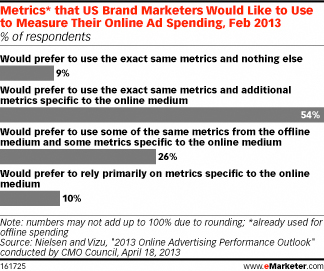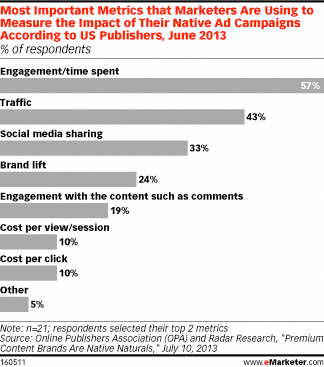CPMs hold Strong as the Standard for Digital Ad Measurement
October 17, 2013
![]() For many years, firms—including eMarketer—have equated formats like banners, rich media, sponsorships and video with brand advertising, while search, classifieds and directories, email, lead generation, and mobile messaging were proxies for direct-response efforts. But in today’s digital ad ecosystem, the lines between objective and format are blurring.
For many years, firms—including eMarketer—have equated formats like banners, rich media, sponsorships and video with brand advertising, while search, classifieds and directories, email, lead generation, and mobile messaging were proxies for direct-response efforts. But in today’s digital ad ecosystem, the lines between objective and format are blurring.
 Multiple factors, including the convergence of digital as both a content and a commerce medium, as well as the rise of multichannel marketing campaigns, are leading marketers to benchmark their digital ad campaigns against both performance- and branding-based objectives—regardless of format, according to a new eMarketer report, “Overview of Digital CPMs: Measures of Digital Performance Place Pressure on Pricing.”
Multiple factors, including the convergence of digital as both a content and a commerce medium, as well as the rise of multichannel marketing campaigns, are leading marketers to benchmark their digital ad campaigns against both performance- and branding-based objectives—regardless of format, according to a new eMarketer report, “Overview of Digital CPMs: Measures of Digital Performance Place Pressure on Pricing.”
 February 2013 data from Nielsen and digital brand advertising measurement firm Vizu supported this observation. Survey results showed 90% of US brand marketers preferred to use at least some digital-specific metrics—be it clicks, views, conversions or sales—to quantify the value of their online investment.
February 2013 data from Nielsen and digital brand advertising measurement firm Vizu supported this observation. Survey results showed 90% of US brand marketers preferred to use at least some digital-specific metrics—be it clicks, views, conversions or sales—to quantify the value of their online investment.
Brand advertisers’ pursuit of performance is affecting the current state of the digital CPM cost structure in several ways. The first and perhaps most direct effect is the willingness of premium and other large-scale publishers to offer both performance- and CPM-based pricing. In contrast, however, some publishers seek to bolster the value of CPMs and preserve the cost structure by building bigger, better and more engaging advertising experiences. Native advertising is one example.
“Advertisers are very excited about native advertising or content marketing opportunities,” said Scott Neslund, executive vice president of media services at advertising agency Centro. “They see higher consumer engagement with these types of customized ads. They also tend to have higher viewability rates, meaning above-the-fold placements.”
Though all of these value-adds justify the command for higher CPMs called for by publishers offering native advertising opportunities, the greater focus on engagement might have brands calling for pricing that follows suit. One such model is CPE, which native ad providers such as YouTube and Twitter offer. Such a pricing structure is a direct reflection of the metric an Online Publishers Association (OPA) and Radar Research study found the majority of US marketers used to measure native advertising: engagement.
Though for many, CPE might be a preferred performance metric, it is unlikely to become a ubiquitous pricing model. “The CPE pricing model can be hard because you need liquidity,” Anthony Risicato, general manager of video advertising platform VideoHub, said. He noted that networks such as Tremor Video or publishers such as YouTube, for example, are able to make such a model work because of their massive amount of inventory, wide reach and ability to more seamlessly integrate advertiser content with their own.
Centro’s Neslund also said he didn’t see performance-based pricing as the future of native advertising: “We’re seeing a CPM model being attached to native advertising for now, and I don’t think that will change.”
Courtesy of eMarketer




























